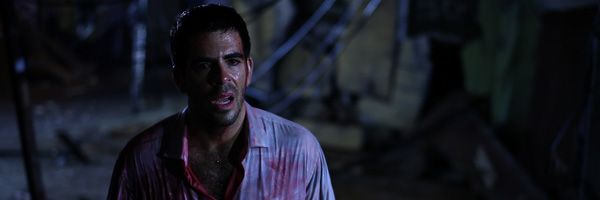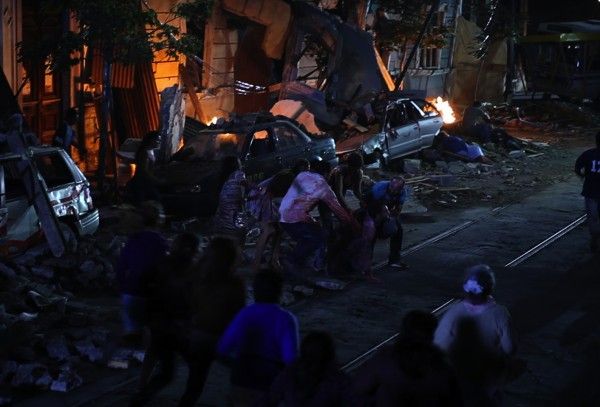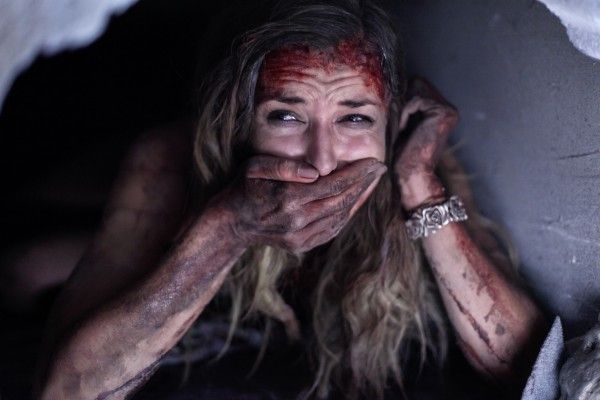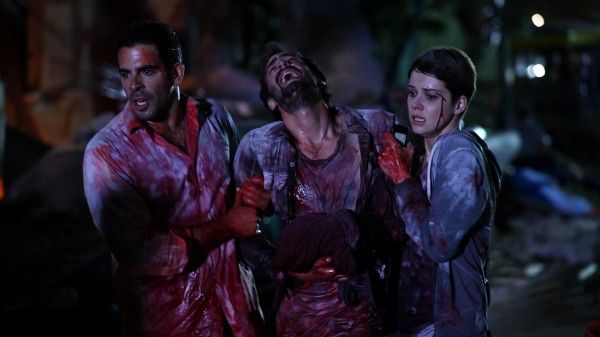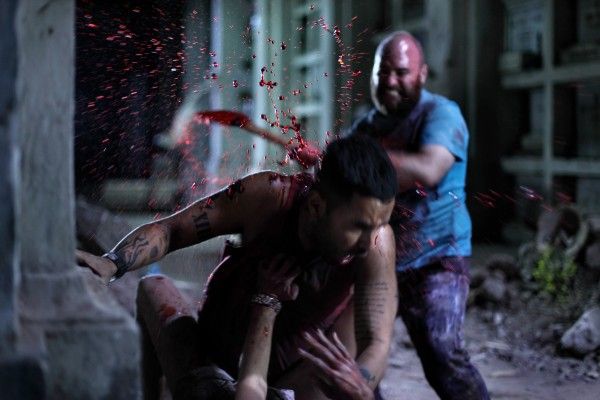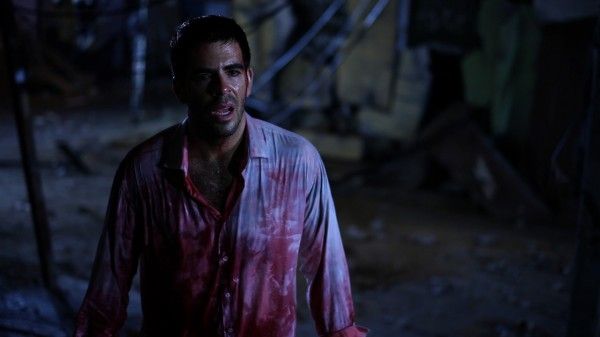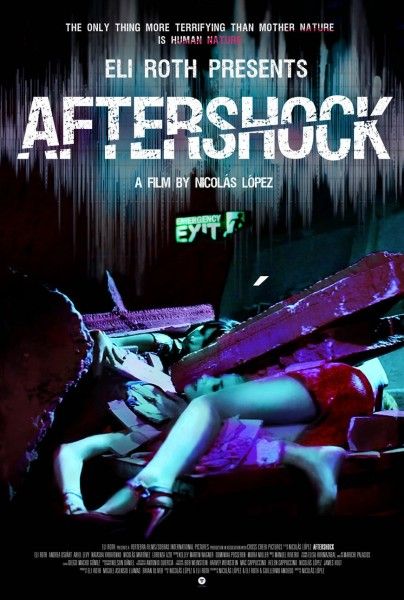Co-writer/producer Eli Roth takes on his first starring role in Aftershock, a fictionalized disaster film loosely based on the 2010 Chilean earthquake. Roth stars as Gringo, an American divorcée touring through Chile with his friends Ariel (Ariel Levy) and Pollo (Nicolas Martinez). After meeting a trio of beautiful women (Andrea Osvart, Lorenza Izzo, and Natasha Yarovenko) the group heads out for a night of drunken debauchery, but when a devastating earthquake hits they must do whatever it takes to survive a night of recurring aftershocks, escaped convicts, and panicking civilians. Directed by Nicolas Lopez, Aftershock takes a decidedly “genre” approach to the subject matter setting up death after bloody death and delivering on gruesome effects. Aftershock is available in select theaters and on VOD May 10th.
At a recent LA press day I sat down with Roth for a one on one interview. We talked about morality in disaster films, how much of the story is based on real events, Nicholas Lopez’s innovative approach to directing, and making a realistic disaster film with a limited budget. We also talked about Green Inferno, his hopes to premiere at Toronto, how new technology is changing the industry, and much more. Hit the jump to check out what he had to say.
Collider: My favorite thing about the disaster genre and survival movies is the way that they pull apart all the bullshit of society and get rights down to the moral questions and who you really are.
ELI ROTH: Oh, that’s great, you really got the movie. The film is about moral choices. One of the reasons we spent a while setting the movie up was to build up the minor problems. We all think about the problems we have in life. I want an iPhone 5, someone said something nasty on twitter, or my boyfriend isn’t texting me back, like whatever the thing is that seems so major in your life, when a real disaster hits you suddenly strips it all away and you see what’s really important and who you really are. We wanted to put the characters in situations where, first of all, you know who everyone is and you know their backstory so you’re with them making that decision, but the film is really a series of moral tests, of hypotheticals. Okay, yes, you’ve survived the earthquake congratulations, now you’re running by a building and you hear a baby crying inside, what do you do? That building could collapse if there’s another aftershock it’s going to collapse with you in it, can you live with that sound of that baby crying knowing you never did anything or do you have to go in and save the child, what do you do?
We wanted people who were out were self-preservation and other people that would take the risk for their friends and it doesn’t always work out on either end of the spectrum, there is no right or wrong and the movie doesn’t judge the people, but it just shows how terrifying is when the rules - this veneer of society is stripped away. Here we are doing an interview, we’re in the magic castle, we’re behaving by the rules and its audio only, you have fifteen minutes, but if there’s an earthquake you’re like running to save your arm, to save your life and people step on each other to get out and that’s what happened. It really all came from real stories talking to Nicolas, a friend of Lorenza’s was in the club and his hands got cut off, it was 3:30 in the morning, they’re partying, this 8.8 earthquake hits and now you literally have no hands, and they had to find the hands, but the club was going to collapse. There was security camera footage of that Nicolas was shown of the club the night of the earthquake and speakers fell on people, people were crushed to death, it was terrifying and that’s the randomness of life. That’s what makes it scary so that’s what we wanted to do was make these situations where suddenly it’s not fun anymore, it’s horrific.
Obviously the movie is mean to be entertaining, but you guys clearly pulled from true stories to build the script, how much of the movie came from true stories and what were your favorite stories you heard?
ROTH: Everything in the movie is taken from a real story including the underground tunnels where the priests and the nuns would meet to have sex and hide the babies, that’s something that’s real and really exists. We knew where they were, but we couldn’t get into them so we recreated them, we built them, but that’s actually all real. Nicolas has the best stories. He told me about a girl he knew who was on a first date with a guy and they went to some lookout point overlooking the city and the earthquake hit and rocks came down and a rock fell on the roof of the car and hit him directly on top of the head and paralyzed him so he was fully paralyzed but conscious and she’s sitting in the passenger seat on a first date. She had to take him out and put him in the back seat, even moving him in the pain he’s in. Then she had to drive the car down the hill, and she didn’t drive stick so the car was bucking and stopping while an earthquake was happening. Nicolas was on the phone with his girlfriend when she was like, “I got out of the club, I survived, but the tsunami sirens just went off- [static noise]” and then the phone went dead so he didn’t know if she was killed in a tsunami. There was a town where there was a tsunami warning and people were panicking and fleeing for the hills and then they were told the tsunami wasn’t going to happen and the sirens went off and people went back to sleep. Two hours later a tsunami hit and wiped out 2000 people. So the stuff that happened- we didn’t want to make the serious Oscar version of it so we fictionalized it. We also wanted to be able to make miner jokes, and this was before the miner thing, so we set it in a fictionalized earthquake, but it’s all based on stuff that really happened. The prisons really broke open, people were looting, there was martial law. It was terrifying.
I would imagine that experience was maybe what made Nicolas want to move into horror when he usually does comedies.
ROTH: Yeah, his comedies are fantastic. They’re all on Netflix. Promedio Rojo and his trilogy Que pena tu vida, , which means Fuck my Life or FML, the next one is Que pena to boda, Fuck my Wedding, and the new one Que pena tu familia, which I’m in, Fuck my Family - they’re all on Netflix with subtitles and people should check them out, but we call this one “Fuck my Hostel” because it starts off like as a Nicolas Lopez movie and turns into an Eli Roth, but the truth is everybody has that other side too. When I’m directing I have that whacky funny side too that I want to exercise and he has that dark side. I remember watching one scene of watching someone getting killed and he was just laughing hysterically. He was like, “It’s so fun to kill your friends, I didn’t realize this.” He’s an amazing director. We shot the entire film with Cannon 5Ds, the Cannon 5D Mark ii, it’s a $2500 SLR camera. He told me that you don’t need an Alexa, you don’t need a RED, you can shoot a feature film on a 5D and he did it. Fuck My Life was the first feature film shot on a Cannon 7D. Then we did things where we put it on a remote control helicopter, because you couldn’t put a helicopter over the vineyards, but you could put a remote control drone, and some guy built this thing, like an octo-cam with eight blades with a remote control. It went all over the city. We have these beautiful helicopter shots. So Nicolas is an incredibly innovative director. One of the great things about that was you could shoot that earthquake scene with five cameras. We did this as a low budget movie shooting fast and we didn’t want it to look like a video game. We wanted everything to look real. So there’s a couple of CG shots, but almost none. Like everything in that club, all the stuff that dropped, even the pieces of concrete that were falling, the things collapsing. There’s a lot of stuff that’s still destroyed form the earthquake, but part of what makes the movie effective is that we really did it and you can feel that it’s real. It’s not CG.
I would agree 100% I was really pleasantly surprised when I saw it last night, because I knew it was a low-budget, I was like, “Oh shit, that looks amazing.”
ROTH: I know, I told Nico the nice thing about shooting in Chile is you get incredible production value. It looks like we spent 20 million dollars making the movie. That’s Nicolas and Antonio Quercia, the DP, who also shot Green Inferno. I basically used the entire team from Aftershock and most of the cast on Green Inferno.
When I spoke to you in January you had just started editing, do you have a rough cut now?
ROTH: Yeah, we have the picture locked and we’re just doing all the sound and music.
Do you have any idea when we might expect a trailer?
ROTH: We won’t have a trailer until we have a release date. We’ve sold it around the world and held back the US, so all the US distributers are circling it. But, I think, if all goes well, I’d like to premiere it at Toronto. There’s nothing confirmed yet, but that’s what I’m on schedule for.
Midnight Madness again?
ROTH: Probably.
With Hemlock Grove you embraced the Netflix medium, you’re doing a VOD release alongside the theatrical release of Aftershock, you really seem to be embracing the opportunities provided by new tech.
ROTH: Well it’s interesting, we want to call this the everywhere release. Looking at movies like Last Exorcism 2 and The Man with the Iron Fists, those movies did well because they cost very little, but the money you spent on it what do you want to do? Do you want to spend money advertising and hope that its makes over a certain number? Or do you want to spend less money advertising, put it in 100-200 screens in the key market? Which is what we’re doing, and the truth is we set out to make this movie in a new way. We said, “Let’s see if we can shoot this thing on a 5D and see if anyone notices.” And I’m telling you now, but when you’re watching it it doesn’t look like it was shot on a $2500 camera because we used really good lenses and put the production in front of it. There’s a new way of making movies, you don’t need all the bullshit that you’ve been told you need. We thought this was actually a great test cast to see how does this work? Right now, obviously you can’t put a movie out against Iron Man unless it’s Great Gatsby or Fast Six, you’re just going to get outspent. I remember Nicolas told me, he goes, “Dude my sister is 14, she watches everything on her iPad, she doesn’t give a fuck how many screens it’s released on.” That’s how she watches movies. Maybe she’ll go with her friends to the theater, but most everything is on her iPad. Obviously I’d love everyone to go see it in the theater and get the big theatrical experience with it.
I just want to throw it out there that I think that’s probably the best way for people to watch this movie.
ROTH: Thank you, please tell people to. Look, maybe the theatrical goes great and it keeps going. We want the theatrical release to do well obviously, but this is an independent movie with a largely unknown cast, outside myself, and a bunch of new actors. It’s getting harder and harder for those types of movies to cut through because you’re just getting outspent. To get someone behind a very fucked up, dark earthquake movie with a largely unknown cast, it’s difficult. But doing it this way, the important thing is that people see it. If you miss a movie in the theaters, it’s gone in three weeks. You have seventeen days to see it, unless it’s one of the tent poles. For instance, I missed Jurassic Park 3D because I was doing press stuff for Hemlock Grove and now here we two, almost three weeks later and I’m like searching every theater for where can I find Jurassic Park 3D? So if you’re having finals, if your life is too busy, if you miss that movie everyone’s watching stuff on iTunes now. So what’s better? To put it out in theaters and have the big theatrical release or to target the websites? We’re looking at movies like Bachelorette and Arbitrage, these movies did very, very well and we thought this is a great test cast. I mean, I don’t know what the answer is, but I can tell you I’m doing all the press. I’m doing this Collider interview, and everyone’s going to read about it on Collider, now they can go see it in theaters or they can just click and order it on iTunes. We don’t necessarily need giant billboards, we can hit people in different ways and I’m in a position where I’m going to do the Jay Leno show tonight, I’m going to do Jimmy Fallon’s show next week, I did the Adam Carolla podcast because I can get out there and promote it to the core audience. So thank you for the positive word of mouth because this is going to be a total word of mouth movie.
Something I really admire about your career is that while you stay true to your genre aesthetic, you never really tread the same ground. You’ve go after every fucking subgenre. What do you think you want to do next?
ROTH: That’s an interesting question. I would like to finish my script for Endangered Species, but I’ve found that every time I say what I’m going to do next my interests change or something new comes along. I remember the best advice was Guillermo del Toro after Cabin Fever I was like, “Do I jump on and do a studio movie now, just to prove that I can be a studio guy? Do I write another indie? What’s the rules? ” and he just goes, “Whatever give you the biggest boner, man. You’ve got to wake up with a rager. You’ve got to want to fuck the shit out of that movie.” And I always found that to be very, very true, very simple, but very true advice. It’s hard for me think about anything else until I get my head out of Green Inferno. I really need to finish it. I’ve realized that some people can multi task, and I have multi tasked. I think I’m overextended now. I have so many different projects I have my hand in, I think I’d like to streamline it a little more and focus on directing. We’ll see. Once Green Inferno’s done, then it will become clear.
Since you are such an expansively educated horror fan, is there anything that you have seen lately that isn’t too well known that you would like to draw attention to?
ROTH: God, that’s such a good question and I’m going to kick myself later for not having the answer to that. I’m trying to think of what I’ve seen recently…god, I’ve only been watching the rough-cuts – well I’m very excited about the rough-cuts of Clown and The Sacrament.
I’m very excited for The Sacrament.
ROTH: It’s awesome. It’s so good. Well, the under-seen movie I think people should check out for Aftershock – the gateway drug movie is Promedio Rojo, Nicolas Lopez’s first movie he made when he was 19, or I would say check out the Que Pena movies, they’re all on Netflix. That’s a great example of what you can do with a 7D and $250,000. All shot on location, shot in 11 days, really smart writing, funny as hell. They’re not horror movies, [laughs] it gets dark at the end of the trilogy, but I think for people that want to make movies it’s a great – he paid for the movie with sponsors so he didn’t owe anyone anything and they were huge hits, they made more money than The Social Network and The Hangover 2 in Chile. It’s a perfect example of innovation, technology, creativity, and drive. He’s made seven movies and he just turned thirty. So I think for filmmakers out there I would suggest that they educate themselves on his movies. It’s just a great example of DIY filmmaking that looks big and theatrical and doesn’t look like a cheap movie.

